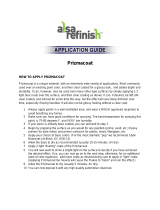• Spray application: See video tutorial on spraying Milk Paint.
Before spraying, strain paint through a medium-mesh
filter. Spray wet films at 3-5-mil thickness. HVLP: 1.8mm-2.0mm
spray tip, medium air cap. Verify tip sizes with your equipment
supplier. See our general guide for spray tip sizes. Keep your
gun at a 90° angle, 6-8" from the surface. On large, flat areas,
use wet, even patterns 6-8" wide. For narrow surfaces, reduce
the fan pattern to 2-3" wide to reduce overspray. Overlap each
pass 25% to conceal lines. Wear full filter NIOSH/MSHA-
approved respiratory & eye protection. Read here for
more information on spraying techniques.
• Face frames on cabinets: Milk Paint can be applied
successfully to cabinet face frames, edges or drawer fronts with
a brush, pad or small cabinet-specific roller such as Whizz or
AllPro brand.
6. Dry 2+ hours between coats and before gf water-based topcoat in
ideal conditions: 70°F/20°C; 50-70% humidity. Be sure to allow
adequate dry time. You can tell if a water-based finish is dry if it forms
a powder when lightly sanded with a fine-grade (220-320) foam sanding
pad. If in doubt, wait longer. Rushing dry time can cause clouding/blush
in topcoat due to moisture trapped between coats. Increase dry time
if:
• Humidity is over 80%
• 3+ coats are applied
• Thick coats are applied
• Applying over an existing sealed finish
• Applying over products from other brands
• Layering General Finishes water- and oil-based products:
• Water over oil: Let oil-based products dry 72+hrs before
applying water-based products
• Oil over water: Let water-based products dry 24+hrs
before applying oil-based products
• To accelerate dry time in humid conditions, add General
Finishes Accelerator and work in a space with good ventilation
and air movement. If you decide to re-coat before the
recommended time, test dryness.
7. Finish sand between coats with a fine-grade (220-320) foam sanding
sponge or 400-grit sandpaper to improve smoothness and adhesion. Do
not use conventional steel wool.
8. Remove dust with a vacuum, compressed air, an oil-free tack cloth or a
water-dampened rag.




